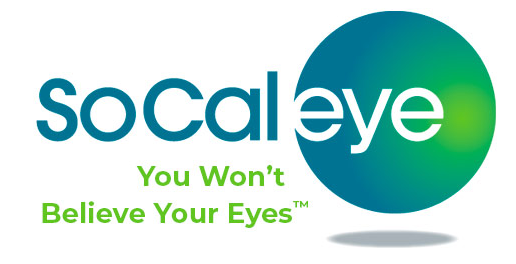SoCal Eye is proud to announce the launch Corneal Collagen Cross Linking (CXL), a new procedure for conditions of the Cornea including Keratoconus and Ectasia. The addition of this important capability places SoCal Eye amongst a select group of Ophthalmology practices in the United States.
Is Cross-Linking Right for Me?
Patients over the age of 14 who have been diagnosed with progressive keratoconus or corneal ectasia following refractive surgery should ask their doctor about corneal cross-linking. SoCal Eye is proud to offer patients in our practice the first and only therapeutic products for corneal cross-linking which have been FDA approved to treat progressive keratoconus.
For more information on the corneal cross-linking procedure, visit www.Livingwithkeratoconus.com/is-cross- linking-right-for-me/.
Will I need to be out of my contact lenses for this process?
Yes. Typically, patients are asked by their doctor to stop wearing hard contact lenses prior to surgery for several weeks. Once treated, patients will not be allowed back into contact lenses for 1 month.
How long does the CXL procedure take?
The procedure takes approximately an hour and a half. Expect to be at SoCal Eye for about 2 hours.
Does CXL hurt?
There is some discomfort during the immediate recovery period, but usually not during the treatment due to the anesthetic eye drops. Immediately following the treatment a bandage contact lens is placed on the surface of the eye to protect the newly treated area. After the numbing drops wear off, there is some discomfort, often described as a gritty, burning sensation managed with Tylenol and preservative free artificial tears.
Am I awake during the procedure?
Yes, typically you will be awake during the treatment. You may be given a medication to help you relax, and numbing anesthetic drops to help keep you comfortable.
Can anyone tell by my appearance that I have had CXL?
No. There is no change in the appearance of your eyes following cross-linking.
How effective is CXL?
Research studies have shown that 60-81% of Corneal Cross-Linking patients experienced an improvement in their vision and 95% of patients experienced no further vision loss. In clinical trials, progressive keratoconus patients had an average reduction of the maximum corneal curvature of up to 1.4 diopters in Study 1 and 1.7 diopters in Study 2 at 12-months following the procedure, while the control group had up to 0.6 diopters of corneal steepening at 12-months. Individual results may vary.
Is CXL a good alternative to corneal transplant?
Corneal Cross-Linking is a less invasive alternative to receiving a Corneal Transplant and can eliminate the need for a corneal transplant. It does not require an operating room, involve incisions into the eye or stiches and eliminates the risk of rejection of the corneal tissue.
How long does corneal cross-linking treatment last?
The benefits of corneal cross-linking appear to last for many years and there is evidence that this strengthening effect may be permanent.
Does cross-linking need to be repeated?
In many studies, the majority of patients responded to a single vitamin and light corneal cross-linking treatment and did not need to have the procedure repeated. Corneal Cross-Linking can often be repeated when treatment is not effective. It is important to not rub your eyes following Corneal Cross-Linking treatment.
When is the best time to have corneal collagen cross-linking?
The results of corneal cross-linking for patients with advanced keratoconus have not been as good as for patients with early disease. It is best administered earlier in the progression of Keratoconus, but your SoCal Eye Cornea Surgeon will guide you accordingly.
When can I resume wearing contact lenses?
Typically, patients can return to wearing contacts 2-6 weeks after the procedure.
Will I need new glasses or contacts after CXL?
Given that Corneal Cross Linking is found to improve the vision of 60-80% of patients it is not uncommon for eye glasses and contact lens prescriptions to require updating. The prescription will change gradually over the 3-6 months after the procedure and will be detected at a follow up exam.
When can I exercise and return to my usual activities after CXL?
A return to normal daily activities after Corneal Collagen Cross-Linking surgery usually takes about 1-2 weeks. You doctor will notify you if a return to an exercise regimen in appropriate.
Is corneal CXL approved by the FDA?
Yes. This procedure was FDA approved in April 2016 although it has been performed and approved by more than 25 European Union nations for more than 15 years. There are some practices in the United States that offer non-FDA approved cross-linking procedures. The results of this type of cross linking have not been studied. It is important to ask your physician if they use the FDA-approved cross-linking system.
Does insurance cover CXL treatment?
Yes. Although not in every case. FDA approved cross-linking is widely covered by insurance. For additional information on insurance coverage and to view the latest list of insurers that are known to have policies that cover cross-linking, visit the Insurance Information page on LivingWithKeratoconus.com.
How much does corneal cross-linking cost?
Contact our office for specific pricing information. It is best to check with your medical carrier before commencing. SoCal Eye can help you understand your coverage.
All treatment begins with a Consultation with a SoCal Eye Cornea Specialist in Long Beach. For Keratoconus Treatment in Long Beach, Schedule an Appointment today at LAKEWOOD (562) 531-2020 | LOS ALAMITOS (562) 598-7728 or send us an Online Consultation Request



